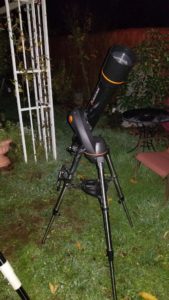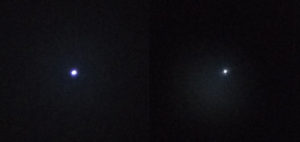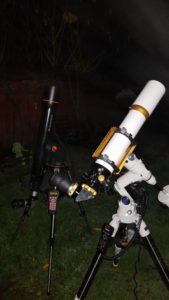Celestron Nexstar 102 GT Achromatic Refractor Review
By: Vlad Fedosov
Intro:
Celestron’s Nexstar 102GT 4” refractor has a reputation for being a bargain gem in the armature astronomy community. When I came across one I was excited to get one out under the stars and see what all the fuss was about. The Nexstar 102GT has a 1000mm focal length and is f/9.8. With a relatively long focal length can the Nexstar 102GT compete with an APO? Well as it so happens I own the William Optics GT102 Triplet APO to compare it to!

Testing:
I bought the full setup Nexstar 102GT that is complete with Celestron’s mount. Even before I got the mount under the night sky I could already tell that this was WAY too much scope for this mount. Getting the scope fully setup out to my backyard was a breeze. I then brought out my WO GT102 setup on the LXD-75. Definitely heavier compared to the light Nexstar but not a big deal as the WO is my primary grab-and-go scope. My backyard has roughly mag 4 skies and the evening of this comparison had hazy skies with low transparency but very good(for my area) seeing.
I had the legs extended on the Nexstar mount by only about 6” in an attempt to make it steadier. I pointed the scope in the direction of Vega as I really wanted to see what the color correction was like(more to come). After getting Vega in the FOV of a 20mm Meade QX eyepiece I waited for the mount to settle the vibration. And I waited. And I waited. I think you get the picture… It took a full 7 seconds for it to settle down. Yes, this mount is not up to the task of a 4” refractor. I think that this mount would be able to handle a 60mm refractor fairly well. An 80mm short tube would likely be the upper limits for it used at low power.
Seeing the stability performance of the Nexstar mount did not instill any continence in me to test out the GOTO performance. I figured I might as well since it would not be a fair review if I did not even give this setup a chance. After doing the 3-star SkyAlign(which is awesome as you just point the scope at any bright 3 stars in the night sky) I was pleasantly surprised that the mount was able to place m57 and m27 in the FOV of the 20mm QX just fine. Nice job Celestron! I’m impressed with the GOTO for such an entry-level mount.
Back it was to Vega. So how was the view? The star was focused nicely in the FOV of the 20mm QX that produced 50x and appeared to be much sharper then it normally does in my c8. The surrounding dimmer stars where perfect pinpoints. There was defiantly color visible around Vega, but not as bad as the other acromats that I have owned in the past. I was impressed. Over it was to my William Optics GT102 to see how it fared compared to the Nexstar. The WO had a 15mm QX which produced 48x in an attempt to make the comparison as fair as possible. Well, what can I say, yes the $2,000 APO produces a more color free image then the $200(on the high end) acromat. The other thing that I did notice is that there was not a major difference in the appearance of dimmer stars, but Vega was definitely a more pinpoint and finer looking orb in the WO. The image attached is a comparison of the color the scopes show. I feel this is a fairly accurate representation of how much color the acromat produces compared to the APO. This was done with just taking pictures with my phone through the eyepiece(crude, I know).

Bumping the magnification on the Nexstar up to 125x with an 8mm 2” Celestron Ultima-XL introduced a different problem. The Nexstar mount could not handle holding the weight of the heavy eyepiece and pointed right down. There is no way to tighten the clutch on the mount and no built-in counterweight to fix this issue. I had to switch this eyepiece out for a lighter Meade 6.5mm HD-60. This produced 154x. The mount was barely able to hold this eyepiece up with a 2” diagonal. The WO APO had the 5mm 2” Celestron Ultima-XL producing 142x. Vega was still a sharp color free orb in the WO. The Nexstar definitely produced an image that was quite full of purple color around the star. Some people are bothered by this, some are not. I guess I’m bothered enough by it to own an APO(though it also has a lot to do with the finer fit and finish of a premium refractor as well as planetary performance).
On it was to the famous Double-Double! To my surprise, the performance of the two scopes on this famous double was almost identical. There was a tiny amount of color visible in the Nexstar but it was something that I really had to look for. The Nexstar produced an image equal to the APO on this object. I was impressed. On it was to a brighter double, Albireo. I went back down to the QX eyepieces on both scopes that produce around 50x. I was thoroughly impressed by the view in the Nexstar of this showpiece object. The stars where nice little orbs with a small airy dist around them. The orange and blue color was easily evident. Looking through the WO APO showed a very similar view with just a hair better definition in the colors of the two stars. I feel like the Nexstar is an excellent scope for double star work and one that will be great for open star clusters as well.
 The last couple of thing that I want to mention is about the focuser of the Nexstar 102GT as well as the dew shield. My unit had a stiff feeling to the focuser which I found to actually help with controlling the focuser a bit. It was certainly very useable at low magnification but did become more of a chore at higher power(the mount did not help this at all). It certainly does not match the $600 Feather Touch focuser on my William Optics GT102(you don’t say right?) but it is usable and I feel is a bit better than the older Chinese units I have used on past refractors. The due shield of this scope is a total joke. It does not extend nearly far enough to actually prevent any dew from forming on the lens or block any stray light.
The last couple of thing that I want to mention is about the focuser of the Nexstar 102GT as well as the dew shield. My unit had a stiff feeling to the focuser which I found to actually help with controlling the focuser a bit. It was certainly very useable at low magnification but did become more of a chore at higher power(the mount did not help this at all). It certainly does not match the $600 Feather Touch focuser on my William Optics GT102(you don’t say right?) but it is usable and I feel is a bit better than the older Chinese units I have used on past refractors. The due shield of this scope is a total joke. It does not extend nearly far enough to actually prevent any dew from forming on the lens or block any stray light.
Conclusion:
If you get a chance to pick up one of these Nexstar 102GT OTA’s at a good price, do yourself a service and grab it! This is especially true if you do not already own an APO or a longer focal length acromat. I feel that you are getting at least 90% of the performance of an APO on double stars, open star clusters, and DSO. I did not get a chance to test this scope on the planets but I think that an APO would pull further ahead on these objects as it will have higher contrast due to the lack of secondary color. With a few simple modifications such as fitting a longer flocked dew shield and maybe flocking the inside of the OTA and focuser, this scope would be a real star at virtually no money. All I can say about the mount is that it just does not work with this scope.
Support AVT-ASTRO
If you found this review helpful and are considering purchasing the product that was discusses please concider purchasing this item on Amazon using the link here. I get a small commission from Amazon and it really helps to pay for running this site! Please note that the Nexstar 102GT is no longer available. Ad is for the newer model.
